| Malo Sa'oloto Tuto'atasi o Samoa Independent State of Samoa | ||||||
|---|---|---|---|---|---|---|
| ||||||
| Motto: Fa'avae i le Atua Samoa (English: Samoa is founded on God) | ||||||
| Anthem: The Banner of Freedom | ||||||
| Capital (and largest city) | Apia 13°50′S 171°45′W / 13.833°S 171.75°W | |||||
| Official language(s) | Samoan, English | |||||
| Demonym | Samoan | |||||
| Government | Parliamentary republic | |||||
| - | O le Ao o le Malo (Head of State) | Tufuga Efi | ||||
| - | Prime Minister | Tuilaepa Aiono Sailele Malielegaoi | ||||
| Independence | from New Zealand | |||||
| - | Date | 1 January 1962[1] | ||||
| Area | ||||||
| - | Total | 2,831 km2 (174th) 1,093 sq mi | ||||
| - | Water (%) | 0.3% | ||||
| Population | ||||||
| - | 2009 estimate | 179,000[2] (166th) | ||||
| - | 2006 census | 179,186 | ||||
| - | Density | 63.2/km2 (134th) 163.7/sq mi | ||||
| GDP (PPP) | 2009 estimate | |||||
| - | Total | $1.049 billion[3] | ||||
| - | Per capita | $5,782[3] | ||||
| GDP (nominal) | 2009 estimate | |||||
| - | Total | $558 million[3] | ||||
| - | Per capita | $3,077[3] | ||||
| HDI (2007) | ||||||
| Currency | Tala (WST) | |||||
| Time zone | (UTC-11) | |||||
| - | Summer (DST) | (UTC-10) | ||||
| Drives on the | left1 | |||||
| ISO 3166 code | WS | |||||
| Internet TLD | .ws | |||||
| Calling code | 685 | |||||
| 1 | Since 7 September 2009.[4] | |||||
Samoa /səˈmoʊ.ə/ (![]() listen), officially the Independent State of Samoa, formerly known as Western Samoa and German Samoa, is a country encompassing the western part of the Samoan Islands in the South Pacific Ocean. It became independent from New Zealand in 1962. The two main islands of Samoa are Upolu and one of the biggest islands in Polynesia, Savai'i. The capital city, Apia, and Faleolo International Airport are situated on the island of Upolu.
listen), officially the Independent State of Samoa, formerly known as Western Samoa and German Samoa, is a country encompassing the western part of the Samoan Islands in the South Pacific Ocean. It became independent from New Zealand in 1962. The two main islands of Samoa are Upolu and one of the biggest islands in Polynesia, Savai'i. The capital city, Apia, and Faleolo International Airport are situated on the island of Upolu.
Samoa was admitted to the United Nations on 15 December 1976.[5] The entire island group, inclusive of American Samoa, was called Navigators Islands by European explorers before the 20th century because of the Samoans' seafaring skills.[6]
Contents[hide] |
[edit] History
The oldest date so far from pre-historic remains in Samoa has been calculated by New Zealand scientists to a likely true age of circa 3,000 years ago from a Lapita site at Mulifanua during the 1970s.[7]
The origins of the Samoans is closely linked to modern research about Polynesia in various scientific disciplines such as genetics, linguistics and anthropology. Scientific research is ongoing although a number of different theories exist, including one proposing that the Samoans originated from Austronesian predecessors during the terminal eastward Lapita expansion period from Southeast Asia and Melanesia between 2,500 and 1,500 BCE.[8] The Samoan origins are currently being reassessed due to new scientific evidence and carbon dating findings from 2003 and onwards.
Intimate sociocultural and genetic ties were maintained between the eastern Lapita colonies and the archaeological record supports oral tradition and native genealogies that indicate inter-island voyaging and intermarriage between prehistoric Samoans, Fijians, and Tongans.

Contact with Europeans began in the early 18th century. Jacob Roggeveen (1659–1729), a Dutchman, was the first known European to sight the Samoan islands in 1722. This visit was followed by a French explorer by the name of Louis-Antoine de Bougainville (1729–1811), the man who named them the Navigator Islands in 1768. Contact was limited before the 1830s which is when English missionaries and traders began arriving.
Mission work in Samoa had begun in late 1830 by John Williams, of the London Missionary Society arriving in Sapapali'i from The Cook Islands and Tahiti.[9] By that time, the Samoans had gained a reputation of being savage and warlike, as violent altercations had occurred between natives and French, British, German and American forces, who, by the late nineteenth century, valued Samoa as a refueling station for coal-fired shipping and whaling. According to Barbara A. West, "The Samoans were also known to engage in “headhunting,” a ritual of war in which a warrior took the head of his slain opponent to give to his leader, thus proving his bravery."[10]
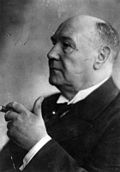

The Germans in particular began to show great commercial interest in the Samoan Islands, especially on the island of 'Upolu where German firms monopolized copra and cocoa bean processing; the United States laid its own claim and formed alliances with local native chieftains, most conspicuously on the islands of Tutuila and Manu'a (which were later formally annexed to the USA as American Samoa).
Britain also sent troops to protect British business enterprise, harbour rights, and consulate office. There followed an eight-year civil war, where each of the three powers supplied arms, training, and in some cases, combat troops to the warring Samoan parties. All three sent warships into Apia harbour, and a larger-scale war seemed imminent, until a massive storm damaged or destroyed the warships, ending the military conflict.[11]
[edit] 20th century
At the turn of the twentieth century, the Tripartite Convention partitioned the Samoan Islands into two parts:[12] the eastern island group became a territory of the United States (the Tutuila Islands in 1900 and officially Manu'a in 1904) and is today known as American Samoa; the western islands, by far the greater landmass, became known as German Samoa after Britain vacated all claims to Samoa and accepted termination of German rights in Tonga and certain areas in the Solomon Islands and West Africa.[13]
The first German Governor was Wilhelm Solf who later went on to become Secretary for the Colonies of Imperial Germany. New Zealand troops landed on 'Upolu unopposed on 29 August 1914 and seized control from the German authorities, following a request by Britain for New Zealand to perform their "great and urgent imperial service."[14]
By 1912, one of the changes the German administration had apparently achieved was its long-term objectives of understanding the traditional forces in Samoa politics, while maintaining a semblance of local participation in government. There was no more Tupu, nor even alii sili, but the two Fautua were appointed. Tumua and Pule were for a time silent; all decisions on matters affecting lands and titles were under the control of the Governor. To complete the process, the Fa’alupega for all Samoa was revised. The Fa’alupega, which had been nationally accepted from at least the late 19th century (and probably for much longer than that), was as follows:
"Tulouna a Tumua ma Pule,
Tulouna a Itu’au ma Alataua,
Tulouna a Aiga-i-le-Tai,
Ma le Va’a-o-Fonoti,
Tulouna a Tama ma a latou aiga
Po’o aiga ma a latou tama".
This Fa’alupega firstly recognized the authority and identity of principal districts of Samoa through their spokesmen – Tumua ma Pule, Itu’au ma Alataua, Aiga-i-le-Tai, ma le Va'a-o-Fonoti – and the highest titles which were bestowed by these groups. It concludes with the recognition of the great maximal descent groups of Samoa and their “sons” who had been chosen to hold the highest titles.
The new Fa’alupega of German Samoa apparently required for Malietoa Tanunafili and Tupua Tamasese to be sworn on oath and to change this Samoa’s historical Fa’alupega to the new fa’alupega as follows:
"Tulouna a lana Maiesitete le Kaisa o le tupu mamalu o lo tatou malo kasialika aoao.
Tulouna a lana afioga le kovana kasialika o le sui o le kaisa I Samoa nei.
Susu mai Malietoa, Afio mai Tupua
Ua fa’amanatuiana ai aiga e lua I o oulua tofiga Kasialika o le Fautua.
Tulouna a le vasega a Faipule Kasialika o e lagolago malosi I le Malo.
Afifio mai le nofo a vasega o tofiga Kasialika o e usu fita I le tautua I le malo".
From the end of World War I until 1962, New Zealand controlled Samoa as a Class C Mandate under trusteeship through the League of Nations.[15] There followed a series of New Zealand administrators who were responsible for two major incidents. In the first incident, approximately one fifth of the Samoan population died in the Influenza epidemic of 1918-1919.[16] In 1919 The Royal Commission of Inquiry into the Epidemic concluded that there had been no epidemic of pneumonic influenza in Western Samoa before the arrival of the 'SS Talune' from Auckland on the 7 November 1918, [which was allowed to berth by the NZ administration in breach of quarantine]; that within seven days of this ship's arrival influenza had become epidemic in Upolu and had then spread rapidly throughout the rest of the territory.[17]
The second major incident arose out of an initially peaceful protest by the Mau (literally translates as "strongly held opinion"), a non-violent popular movement which had its beginnings in the early 1900s on Savai'i and led by Lauaki Namulauulu Mamoe, an orator chief deposed by Solf. In 1909, Lauaki was exiled to Saipan and died en route back to Samoa in 1915.
By 1918, the New Zealand administrator governed a population of some 38,000 Samoans and 1,500 Europeans.[18][copyright violation?] By the late 1920s the resistance movement against colonial rule had gathered widespread support during the mistreatment of the Samoan people by the New Zealand administration. One of the Mau leaders was Olaf Frederick Nelson, a half Samoan and half Swedish merchant.[19] Nelson was eventually exiled during the late 1920s and early 1930s, but he continued to assist the organization financially and politically. In following the Mau's non-violent philosophy, the newly elected leader, High Chief Tupua Tamasese Lealofi, led his fellow uniformed Mau in a peaceful demonstration in downtown Apia on 28 December 1929.[20]
The New Zealand police attempted to arrest one of the leaders in the demonstration. When he resisted, a struggle developed between the police and the Mau. The officers began to fire randomly into the crowd and a Lewis machine gun, mounted in preparation for this demonstration, was used to disperse the Mau.[21] Chief Tamasese was shot from behind and killed while trying to bring calm and order to the Mau demonstrators, screaming "Peace, Samoa". Ten others died that day and approximately 50 were injured by gunshot wounds and police batons.[22]
That day would come to be known in Samoa as Black Saturday. The Mau grew, remaining steadfastly non-violent, and expanded to include a highly influential women's branch. After repeated efforts by the Samoan people, Western Samoa gained independence in 1962 and signed a Friendship Treaty with New Zealand. Samoa was the first country in the Pacific to become independent. In 2002, New Zealand's prime minister Helen Clark, on a trip to Samoa, formally apologised for New Zealand's role in these two incidents.[23][24]
In July 1997, the constitution was amended to change the country's name from Western Samoa to Samoa.[25] The U.S. territory of American Samoa protested the move, asserting that the change diminished its own identity. American Samoans still use the terms Western Samoa and Western Samoans to describe the independent State of Samoa and its inhabitants.
While the two Samoas share language and ethnicity, their cultures have recently followed different paths, with American Samoans often emigrating to Hawaiʻi and the U.S. mainland, and adopting many U.S. customs, such as the playing of American football and baseball. Western Samoans have tended to emigrate instead to New Zealand, whose influence has made the sports of rugby and cricket more popular in the western islands. Travel writer Paul Theroux noted that there were marked differences between the societies in Samoa and American Samoa..[26]
Effective 7 September 2009, the government has changed the driving orientation for motorists and Samoans now drive on the left side of the road. This brings Samoa into line with many other countries in the region. Samoa is the first country in recent years, and the first country in the 21st century, to switch to driving on the left.[27]
[edit] Politics
| Samoa |
 This article is part of the series: |
| |
| |
[edit] 20th Century politics
The 1960 Constitution, which formally came into force with independence from New Zealand in 1962, is based on the British pattern of parliamentary democracy, modified to take account of Samoan customs.[28] The national modern Government of Samoa is referred to as the 'Malo'. Samoa's first Prime Minister was Fiame Mata'afa Faumuina Mulinu’u II, one of the four highest ranking paramount chiefs in the country. Two other paramount chiefs at the time of independence were appointed joint heads of state for life. Tupua Tamasese Mea'ole, who died in 1963, leaving Malietoa Tanumafili II sole head of state until his death on 11 May 2007, upon which Samoa transitioned from a constitutional monarchy to a republic. The next Head of State Tuiatua Tupua Tamasese Efi was elected by the legislature on 17 June 2007 for a fixed 5 year term.[29]
The unicameral legislature (Fono) consists of 49 members serving 5-year terms. Forty-seven are matai title holders elected from territorial districts by Samoans; the other two are chosen by non-Samoans with no chiefly affiliation on separate electoral rolls.[30] Universal suffrage was extended in 1990, but only chiefs (matai) may stand for election to the Samoan seats. There are more than 25,000 matais in the country, about 5% of whom are women.[31] The prime minister is chosen by a majority in the Fono and is appointed by the head of state to form a government. The prime minister's choices for the 12 cabinet positions are appointed by the head of state, subject to the continuing confidence of the Fono.
Prominent women in Samoan politics include the late Laulu Fetauimalemau Mata'afa (1928–2007) from Lotofaga constituency, the wife of Samoa's first prime minister. Their daughter Fiame Naomi Mata'afa is a paramount chief and a long-serving senior member of cabinet. Other women in politics include Samoan scholar and eminent professor Aiono Fanaafi Le Tagaloa, orator-chief Matatumua Maimoana and Safuneitu'uga Pa'aga Neri, the current Minister of Communication and Technology.
The judicial system is based on English common law and local customs. The Supreme Court of Samoa is the court of highest jurisdiction. Its chief justice is appointed by the head of state upon the recommendation of the prime minister.
[edit] Political districts
Samoa is made up of eleven itūmālō (political districts). These are the traditional eleven districts that were established well before European arrival. Each district has its own constitutional foundation (faavae) based on the traditional order of title precedence found in each district's faalupega (traditional salutations).
The capital village of each district administers and coordinates the affairs of the district and confers each districts' paramount title, amongst other responsibilities. For example, the District of A'ana has its capital at Leulumoega. The paramount title of A'ana is the TuiA'ana. The orator group which confers this title - the Faleiva (House of Nine) - is based at Leulumoega. This is also the same for the other districts. In the district of Tuamasaga, the paramount title of the district - The Malietoa title - is conferred by the FaleTuamasaga based in Afega.
|
1 including islands Manono, Apolima and Nu'ulopa
2 including the Aleipata Islands and Nu'usafe'e Island
3 smaller parts also on Upolu (Salamumu (incl. Salamumu-Utu) and Leauvaa villages)
[edit] Geography
The country is located east of the international date line and south of the equator, about halfway between Hawai‘i and New Zealand in the Polynesian region of the Pacific Ocean. The total land area is 2,934 km² (1,133 sq mi) (slightly smaller than the U.S. state of Rhode Island), consisting of the two large islands of Upolu and Savai'i which account for 99% of the total land area, and eight small islets. The land area is about the size of the two Hawaii islands Oahu and Maui combined.
These are the three islets in the Apolima Strait (Manono Island, Apolima and Nu'ulopa), the four Aleipata Islands off the eastern end of Upolu (Nu'utele, Nu'ulua, Namua, and Fanuatapu), and Nu'usafe'e (less than 0.01 km² - 2½ acres - in area and about 1.4 km (0.9 mi) off the south coast of Upolu at the village of Vaovai).[32] The main island of Upolu is home to nearly three-quarters of Samoa's population, and its capital city is Apia.
[edit] Climate
The climate is equatorial/monsoonal, with an average annual temperature of 26.5°C (79.7°F), and a rainy season from November to April.[33] Savai'i is the largest of the Samoan islands and the sixth largest Polynesian island after New Zealand's North, South and Stewart Islands and the Hawaiian islands of Hawaiʻi and Maui. The population of Savai'i is 42,000 people.
| [hide]Climate data for Apia | |||||||||||||
|---|---|---|---|---|---|---|---|---|---|---|---|---|---|
| Month | Jan | Feb | Mar | Apr | May | Jun | Jul | Aug | Sep | Oct | Nov | Dec | Year |
| Average high °C (°F) | 30 (86) | 30 (86) | 30 (86) | 30 (86) | 30 (86) | 29 (84) | 29 (84) | 29 (84) | 29 (84) | 30 (86) | 30 (86) | 30 (86) | 30 (86) |
| Average low °C (°F) | 24 (75) | 24 (75) | 24 (75) | 24 (75) | 24 (75) | 24 (75) | 23 (73) | 23 (73) | 23 (73) | 24 (75) | 24 (75) | 24 (75) | 24 (75) |
| Precipitation mm (inches) | 419 (16.5) | 322 (12.68) | 332 (13.07) | 261 (10.28) | 205 (8.07) | 165 (6.5) | 133 (5.24) | 155 (6.1) | 180 (7.09) | 257 (10.12) | 270 (10.63) | 372 (14.65) | 3,071 (120.91) |
| Source: www.weather2travel.com"Apia climate guide". http://www.weather2travel.com/climate-guides/index.php?destination=apia. | |||||||||||||
[edit] Geology
The Samoan islands have been produced by vulcanism, the source of which is the Samoa hotspot which is the probable result of a mantle plume.[34][35] While all of the islands have volcanic origins, only Savai'i, the western most island in Samoa, is volcanically active with the most recent eruptions in Mt Matavanu (1905–1911), Mata o le Afi (1902) and Mauga Afi (1725). The highest point in Samoa is Mt Silisili, at 1858 m (6,096 ft). The Saleaula lava fields situated on the central north coast of Savai'i are the result of the Mt Matavanu eruptions which left 50 km² (20 sq mi) of solidified lava.[36]
[edit] Economy


The country currency is the Samoan tālā, issued and regulated by the Central Bank of Samoa.[37] The economy of Samoa has traditionally been dependent on agriculture and fishing at the local level. In modern times, development aid, private family remittances from overseas, and agricultural exports have become key factors in the nation's economy. Agriculture employs two-thirds of the labour force, and furnishes 90% of exports, featuring coconut cream, coconut oil, noni (juice of the nonu fruit, as it is known in Samoan), and copra.[38]
Outside of a large automotive wire harness factory (Yazaki Corporation), the manufacturing sector mainly processes agricultural products. Tourism is an expanding sector which now accounts for 25% of GDP. Tourist arrivals have been increasing over the years with more than 100,000 tourists visiting the islands in 2005, up from 70,000 in 1996.
The Samoan government has called for deregulation of the financial sector, encouragement of investment, and continued fiscal discipline.[citation needed] Observers point to the flexibility of the labour market as a basic strength for future economic advances.[citation needed] The sector has been helped enormously by major capital investment in hotel infrastructure, political instability in neighboring Pacific countries, and the 2005 launch of Polynesian Blue a joint-venture between the government and Virgin Airlines.
Samoa is a fertile, fruitful, productive archipelago. In the period before German colonization, it produced mostly copra. German merchants and settlers were active in introducing large scale plantation operations and developing new industries, notably cocoa bean and rubber, relying on imported labourers from China and Melanesia. When the value of natural rubber fell drastically, about the end of the Great War (World War I), the New Zealand government encouraged the production of bananas, for which there is a large market in New Zealand.[citation needed]
Because of variations in altitude, a large range of tropical and subtropical crops can be cultivated, but land is not generally available to outside interests. Of the total land area of 2,934 km² (725,000 acres), about 24.4% is in permanent crops and another 21.2% is arable. About 4.4% is Western Samoan Trust Estates Corporation (WSTEC).[citation needed]
The staple products of Samoa are copra (dried coconut meat), cocoa bean (for chocolate), and bananas. The annual production of both bananas and copra has been in the range of 13,000 to 15,000 metric tons (about 14,500 to 16,500 short tons). If the rhinoceros beetle in Samoa were eradicated, Samoa could produce in excess of 40,000 metric tons (44,000 short tons) of copra. Samoan cocoa beans are of very high quality and used in fine New Zealand chocolates. Most are Criollo-Forastero hybrids. Coffee grows well, but production has been uneven. WSTEC is the biggest coffee producer. Rubber has been produced in Samoa for many years, but its export value has little impact on the economy.[citation needed]
Other agricultural industries have been less successful. Sugarcane production, originally established by Germans in the early 20th century, could be successful. Old train tracks for transporting cane can be seen at some plantations east of Apia. Pineapples grow well in Samoa, but beyond local consumption have not been a major export.
[edit] Components of the economy
Gross Domestic Product (GDP) in purchasing power parity (PPP) in 2006 was estimated at $1.218 billion USD.[citation needed] The industrial sector is the largest component of GDP at 58.4%, followed by the services sector at 30.2% (2004 est.). Agriculture represents only 11.4% of GDP (2004 est.). Samoan labor force is estimated at 90,000.[citation needed]
[edit] Demographics
Samoa has a population of 182,265 of which 92.6% are Samoans, 7% Euronesians (people of mixed, European and Polynesian ancestors) and 0.4% are Europeans, per the CIA World Factbook. About three-quarters of the population live on the main island of Upolu.[28] Only the Māori of New Zealand outnumber Samoans among Polynesian groups.
[edit] Religion
Samoans' religious adherence includes the following: Christian Congregational Church of Samoa 35.5%, Roman Catholic 19.6%, Methodist 15%, Latter-day Saints 12.7%, Samoan Assemblies of God 10.6%, Seventh-day Adventist 3.5%, Worship Centre 1.3%, unspecified 0.8% (2001 census).[39]
The Head of State until 2007, His Highness Malietoa Tanumafili II, was a Bahá'í convert. Samoa hosts one of seven Bahá'í Houses of Worship in the world; completed in 1984 and dedicated by the Head of State, it is located in Tiapapata, 8 km (5 mi) from Apia.
[edit] Culture
The fa'a Samoa, or traditional Samoan way, remains a strong force in Samoan life and politics. Despite centuries of European influence, Samoa maintains its historical customs, social and political systems, and language. Cultural customs such as the Samoa 'ava ceremony is a significant and solemn ritual at important occasions including the bestowal of matai chiefly titles. Items of great cultural value include the finely woven 'ie toga.
Samoan mythology include many gods with creation stories and figures of legend such as Tagaloa and the goddess of war Nafanua, the daughter of Saveasi'uleo, ruler of the spirit realm Pulotu. Other legends include the well known story of Sina and the Eel which explains the origins of the first coconut tree.
Some Samoans are spiritual and religious, and have subtly adapted the dominant religion of Christianity to 'fit in' with fa'a Samoa and vice versa. As such, ancient beliefs continue to co-exist side-by-side with Christianity, particularly in regard to the traditional customs and rituals of fa'a Samoa. The Samoan culture is centered around the principle of vāfealoa'i, the relationships between people. These relationships are based on respect, or fa'aaloalo. When Christianity was introduced in Samoa, most Samoan people converted. Currently 98% of the population identify themselves as Christian. The other 2 percent either identify themselves as irreligious, or do not belong to any congregation.
Some Samoans live a communal way of life, participating in activities collectively. Examples of this are the traditional Samoan fale (houses) which are open with no walls, using blinds made of coconut palm fronds during the night or bad weather.
The Samoan word for dance is siva with unique gentle movements of the body in time to music and which tells a story, although the Samoan male dances can be more physical and snappy.[40] The sasa is also a traditional dance where rows of dancers perform rapid synchronised movements in time to the rhythm of wooden drumms (pate) or rolled mats. Another dance, performed by males is called the fa'ataupati or the slap dance, creating rhythmic sounds by slapping different parts of the body. This is believed to have been derived from slapping insects on the body.
The form and construction of traditional architecture of Samoa was a specialised skill by Tufuga fai fale that also linked to other cultural artforms.
[edit] Tattooing

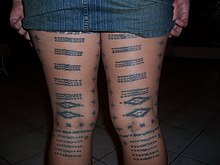
As with other Polynesian cultures (Hawai'ian, Tahitian and Māori) with significant and unique tattoos, Samoans have two gender specific and culturally significant tattoos. For males, it is called the Pe'a and consists of intricate and geometrical patterns tattooed that cover areas from the knees up towards the ribs. A male who possesses such a tatau is called a soga'imiti. A Samoan girl or teine is given a malu, which covers the area from just below her knees to her upper thighs.[41]
[edit] Contemporary culture
Albert Wendt is a significant Samoan writer whose novels and stories tell the Samoan experience. In 1989, his novel Flying Fox in a Freedom Tree was made into a feature film in New Zealand, directed by Martyn Sanderson.[42] Another novel Sons for the Return Home had also been made into a feature film in 1979, directed by Paul Maunder.[43] Other Samoan poets and writers include Sapa'u Ruperake Petaia, Eti Sa'aga and Savea Sano Malifa, the editor of the Samoa Observer.
The late John Kneubuhl, born in American Samoa, was an accomplished playwright and screenwriter and writer Sia Figiel won the 1997 Commonwealth Writers' Prize. Momoe Von Reiche is an internationally recognised poet and artist. Popular bands include The Five Stars, Penina o Tiafau and Punialava'a. There are also many contemporary Samoan artists living around the world. These Samoan artists include writers, filmmakers, visual artists, actors, directors, singers and dancers. In contemporary dance in New Zealand Lemi Ponifasio is a director and choreographer who is prominent internationally with his Company MAU[44] and Neil Ieremia'sc company Black Grace has also received international acclaim with tours to Europe and New York. The arts organisation Tautai is a collective of visual artists including Fatu Feu'u, Johnny Penisula, Shigeyuki Kihara, Iosefa Leo, Michel Tuffery, John Ioane and Lily Laita.[45]
In film, director Sima Urale is an award-winning filmmaker. Urale's short film O Tamaiti won the prestigious Best Short Film at the Venice Film Festival in 1996. Her first feature film Apron Strings opened the 2008 NZ International Film Festival. The feature film Siones Wedding, co-written by Oscar Kightley, was financially successful following premieres in Auckland and Apia. In music, the cover of the song Sweet Inspiration by The Yandall Sisters reached number one on the charts while King Kapisi was the first hip hop artist to receive the prestigious New Zealand APRA Silver Scroll Award in 1999 for his song Reverse Resistance. His music video Reverse Resistance was filmed in Savai'i at his villages. Other successful Samoan hip hop artists include rapper Scribe, Dei Hamo, Savage and Tha Feelstyle whose music video Suamalie was filmed in Samoa.
In comedy, Laughing Samoans, the Naked Samoans and Kila Kokonut Krew have enjoyed sold-out tours. Actor and director Nathaniel Lees has featured in many theatre productions and films including his role as Captain Mifune in The Matrix movie trilogy. In theatre, published playwrights include Oscar Kightley, Victor Rodger, Makerita Urale and Niuean Samoan playwright Dianna Fuemana.[46] Tusiata Avia is a performance poet. Her first book of poetry Wild Dogs Under My Skirt was published by Victoria University Press in 2004.
International influences like hip hop impact on Samoan culture. According to Katerina Martina Teaiwa, PhD from the University of Hawai'i at Manoa, "Hip hop culture in particular is popular amongst Samoan youth."[47] This is not surprising considering the large amounts of migration between Samoa, Hawaii, and the United States mainland, specifically California. In addition, the integration of hip hop elements into Samoan tradition also "testifies to the transferability of the dance forms themselves," and to the "circuits through which people and all their embodied knowledge travel."[48] Dance both in its traditional form and its more modern forms has remained a central cultural currency to Samoans, especially youths.[47]
[edit] Sport
The main sports played in Samoa are Rugby Union, Samoan cricket and netball. Rugby Union is the national football code of Samoa. In Samoan villages, volleyball is also popular.
Rugby union is very popular in Samoa and the national team, nicknamed the Manu Samoa, is consistently competitive against teams from vastly more populous nations. Samoa has competed at every Rugby World Cup since 1991, and made the quarter finals in 1991, 1995 and the second round of the 1999 world cup.[49] At the 2003 world cup, Manu Samoa came close to beating eventual world champions, England. Samoa also played in the Pacific Nations Cup and the Pacific Tri-Nations The sport is governed by the Samoa Rugby Football Union, who are members of the Pacific Islands Rugby Alliance, and thus, also contribute to the international Pacific Islanders rugby union team.
At club level there is the National Provincial Championship and Pacific Rugby Cup Prominent Samoan players include Pat Lam and Brian Lima. In addition there are many Samoans that have played for or are playing for the New Zealand All Blacks. They also took home the cup at Wellington and the Hong Kong Rugby Sevens in 2007—for which the Prime Minister of Samoa, also Chairman of the national rugby union, Tuila’epa Sa’ilele Malielegaoi, declared a national holiday. They also were the IRB World Sevens Series Champions in 2010 capping a year of achievement for the Samoans, following wins in the USA, Australia, Hong Kong and Scotland Sevens tournaments.
Rugby league is also popular amongst Samoans, with Samoa reaching the quarter finals of the 2000 Rugby League World Cup. Many Samoans and New Zealanders or Australians of Samoan descent play in the Super League and National Leagues in Britain. Examples are Va'aiga Lealuga Tuigamala who represented the New Zealand All Blacks, then became the first million dollar player to be contracted out to Rugby League to play for Wigan, then played Rugby Union for Newcastle Falcons before representing Samoa. Ta'ane Lavulavu of Workington Town, Maurie Fa'asavalu of St Helens and David Fatialofa of Whitehaven.
Samoans have been very visible in boxing, kickboxing, wrestling, and sumo; some Samoan sumos, most famously Musashimaru and Konishiki have reached the highest rank of Ozeki and yokozuna. Despite the relatively small population of the islands many Samoans and people of Samoan descent have reached high ranks in many professional sports leagues. Also David Tua is a very well known Samoan boxer.
American Football is played limitedly in Samoa, reflecting its wide popularity in American Samoa, where the sport is played under high school sanction. About 30 ethnic Samoans, many from American Samoa, currently play in the National Football League. A 2002 article from ESPN estimated that a Samoan male (either an American Samoan, or a Samoan living in mainland United States) is 40 times more likely to play in the NFL than a non-Samoan American.[50]

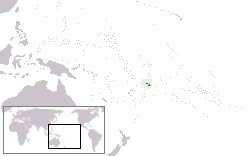

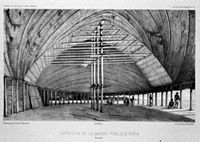
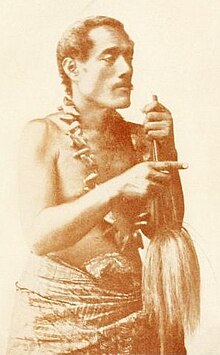

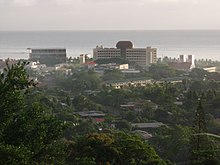
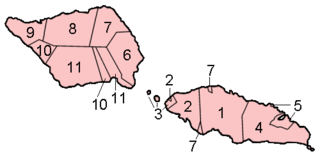






No comments:
Post a Comment